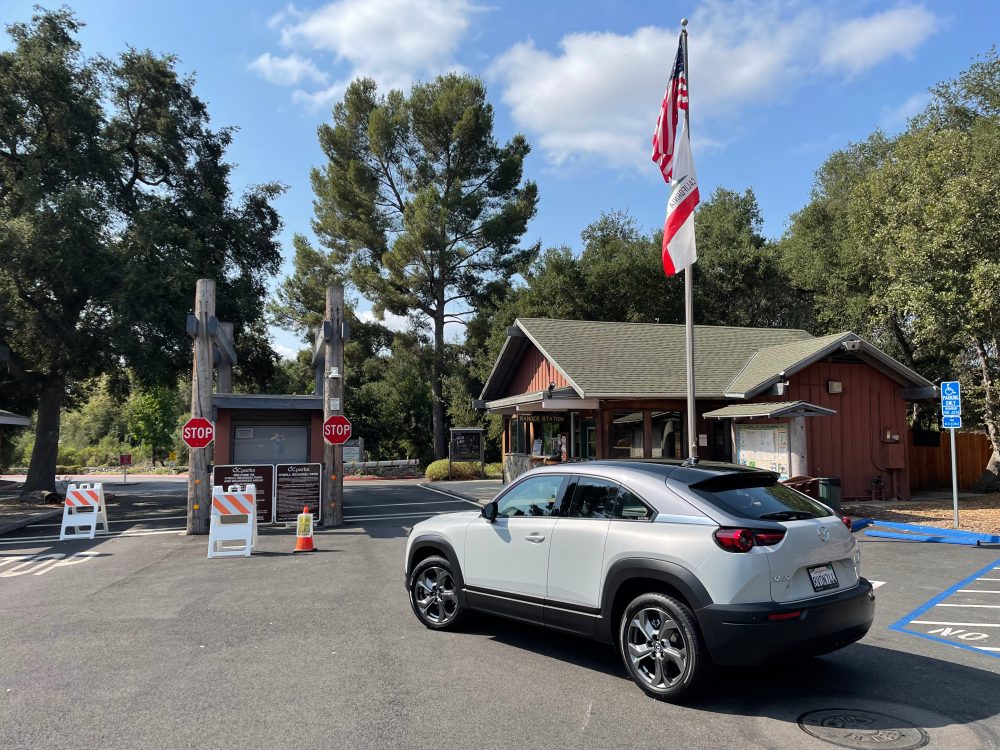Mazda invited us out for a drive of its upcoming MX-30 electric compact SUV, and some conversations with Mazda’s Irvine R&D folks. We have a lot of thoughts to share about the car and the future of Mazda’s EV programs.
To start with a few headline specs, the Mazda MX-30 starts at an MSRP of $33,470 for the base model or $36,480 with the “Premium Plus” package (plus $1,175 destination fees). Federal, state and local incentives bring that price down significantly, into the mid-20s.
It has a 35.5kWh battery good for about 100 miles of range with a 143hp (107kW) motor capable of 200lb-ft (271Nm) of torque and a 0-60 time of about 9 seconds. It’s also capable of 50kW DC quick charging with a CCS combo plug. It will be available in California dealerships imminently.
This is technically not Electrek’s “first” article about the MX-30, as our British counterparts at Fully Charged have posted about the European version of the car before. This is, however, our first drive of a US car from a US perspective.
Our drive took us through mixed Southern California driving on highways, in traffic, in canyons, and along the coast. It was your typical “hey, let’s go for a drive” kind of day in and around Orange County in typical perfect sunny weather.
Performance
While the Mazda MX-30 isn’t a sports car, the inherent benefits of electric motors make it possible for any EV to offer a fun and peppy driving experience.
Mazda emphasized that they were “surprised” by the possible improvements in vehicle dynamics by switching to an electric powertrain, despite the MX-30’s ~300lb weight penalty over the gas CX-30. These benefits include a 2 inch lower center of gravity, harder motor mounts, higher chassis rigidity, and tires with more lateral stiffness for better steering response. The more responsive electric motor enables better “g-vectoring control,” a Mazda technology that modifies the engine’s torque to help weight-shifting during corners. Also, unlike a lot of front-wheel-drive EVs, the MX-30 did not display noticeable torque steer.
On our trip through the canyons, the car handled quite nicely. It felt smooth and responsive through the corners, in the way a lot of SUVs wouldn’t. We didn’t push it particularly hard, but the car felt lively and capable nonetheless.
The roughly nine-second 0-60 time, though, is where it all falls apart. The MX-30’s throttle response is quick enough it doesn’t feel laggy, but it isn’t very powerful. When you really slam the throttle down, the car does accelerate immediately, but the acceleration just isn’t very…convincing. Part of the reason we didn’t push the car too hard in the canyons is that, well, we couldn’t. It just doesn’t have that same feeling of instant torque that more powerful EVs (read: virtually all of them) have.
We reported before that Mazda made the MX-30 slower “to feel more like a gas car.” Throughout the drive, we did not find acceleration and power delivery to be particularly inspiring. Mazda told us that its reason is that EVs with instant torque can be too “herky-jerky,” which can ruin the passenger experience. So Mazda muted the “jerkiness” of acceleration to follow the same curve as an ICE car.

Mazda reiterated a common refrain we’ve heard from many automakers, that part of its reasoning here was to keep the car familiar to its gas customers. As I’ve stated before, EVs are generally better the further they get from this mentality. This allows automakers to focus on the advantages of EVs to make a better vehicle, rather than keeping the old ways for familiarity’s sake. Rather than the oft-repeated goal of making “a great car that happens to be electric,” one could make “a better car because it’s electric.”
A major reason for this lack of throw-you-back-in-the-seat acceleration is the car’s relatively small battery. Every battery technology has to make some compromises between energy density, weight, charging time, and more. In general, the way to get more power out of an EV battery is to make it bigger. This is why the upcoming Next-Gen Tesla Roadster is slated to have a 200kWh battery and why Rivian‘s truck and SUV can go 0-60 in about three seconds with their huge 135kWh+ battery powering four wheel motors.
So the MX-30’s 35.5kWh battery, which is comparatively small versus other cars on the road these days, isn’t going to match the field in acceleration. It’s even slower than the 32.6kWh Mini Cooper SE and its 6.9 second 0-60 time, or the 40kWh base Nissan Leaf‘s 7.4 second time.
The weight distribution is odd, too. The MX-30 is a front-wheel drive, but the battery is low and more towards the rear of the vehicle. As a result, it has a 40/60 front-rear weight distribution – the opposite of the gas CX-30’s 60/40 distribution. This means that the drive wheels don’t have as much weight over them, which means that traction, especially under initial acceleration, will be reduced as the vehicle’s weight shifts even more to the rear.
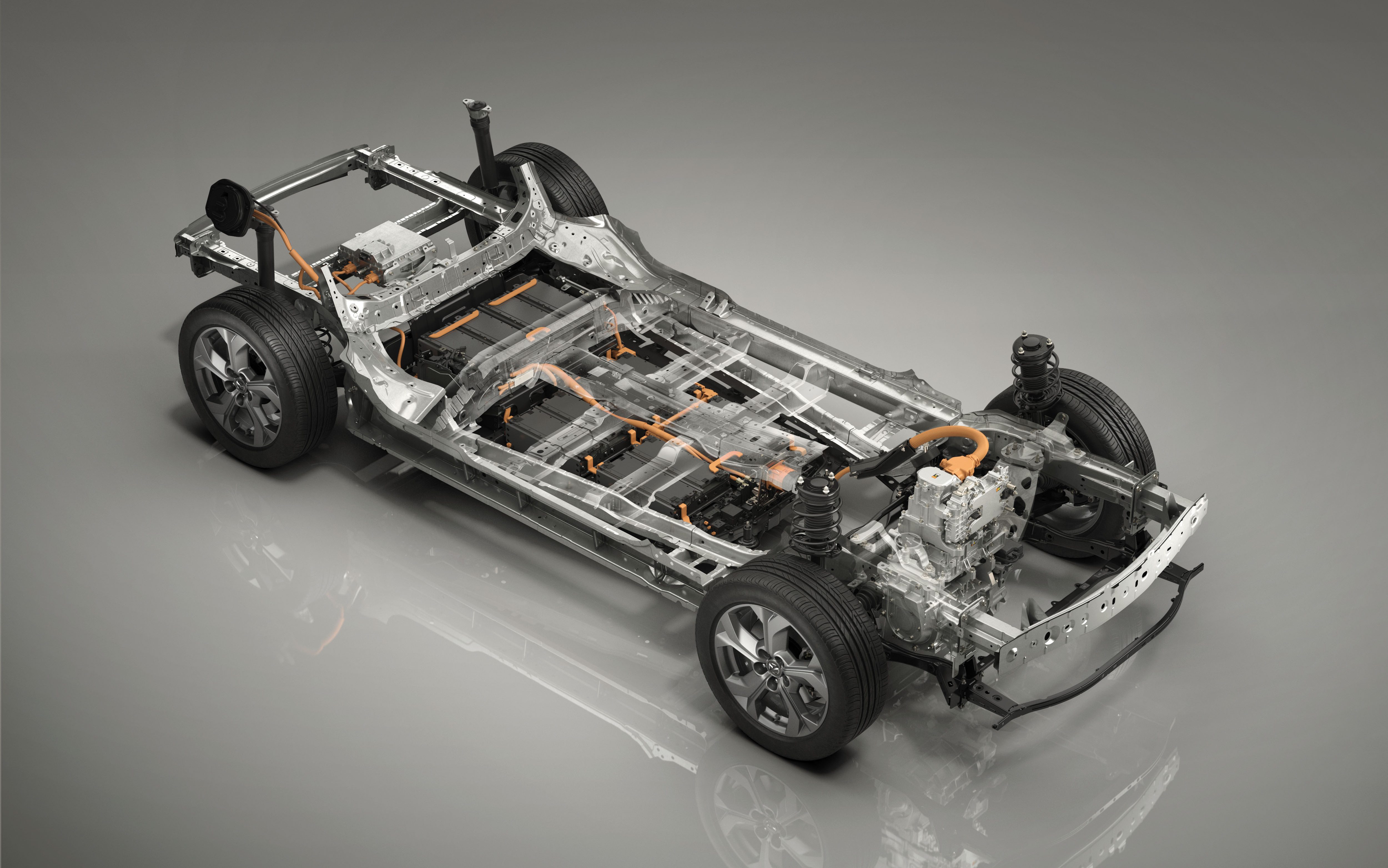
Perhaps this odd weight distribution is another reason Mazda intentionally added a gradual ramp to the car’s torque delivery under acceleration. If Mazda didn’t, it would be very easy to spin the front wheels. I’ve driven another EV with this issue – the original Mini E, which had a wonky back-heavy weight distribution because it was a retrofit that replaced the rear seats with 600lbs of batteries. This was fun (and enabled me to chirp tires easily when I felt like being silly) but is not ideal for driving dynamics. So good on Mazda for solving that problem, but it would have been better to solve it with better battery or motor placement, both of which would have been possible if the MX-30 had its own platform instead of sharing it with the CX-30 and an upcoming PHEV.
To be fair, this is not meant to be a sportscar. The amount of acceleration it offers will be fine for normal day-to-day tasks. It’s just not super inspiring, is all.
This seems to run counter to Mazda’s “zoom-zoom” ethos (which they have updated to “sustainable zoom-zoom”). While Mazda has never been known for having particularly powerful vehicles, they have always made sporty, fun, “tossable” cars. The MX-30 feels pretty good in corners, but when the throttle pedal doesn’t give you as much as you’d like, that puts a damper on the whole thing.
Range and efficiency
The Mazda MX-30 is a relatively low-range vehicle. Its 35.5kWh battery is worth about 100 miles of range, and in our testing, that seemed accurate. After a morning of mixed driving in perfect Southern California weather, we managed 61 miles while using 59% of the battery, with 43 miles left until empty on the indicator. In worse weather (or if you’re a more spirited driver), you’ll probably get worse mileage. If you hypermile, you can probably do a bit better than that.
Mazda maintains that there is room in the ecosystem for low-range vehicles, underlining that most people drive 30 miles a day, which means a 100-mile battery is more than enough.
We at Electrek agree that there is room for low-range vehicles in the EV ecosystem. There are many people who can get away with much less range than they think they need, and in doing so, will get a vehicle that is cheaper, more efficient, more nimble, and less wasteful of limited battery resources (which could be used to build another EV, and displace another gas car off of the road, resulting in better net overall emissions reductions across the fleet).
I am actually happy to have the MX-30 on this end of the range spectrum. There are plenty of use cases for which a small SUV with a commute and around-town range makes sense. The MX-30 could work as the main car in a two-car household, for grocery trips, taking the kids and dogs to a local hike or park, as an everyday commuter, and so on. I promise you that a car with a 100-mile range will fit a lot into a lot of people’s lives better than you think – probably even yours, reader.
For the times that it doesn’t, Mazda gives MX-30 owners 10 days of free rentals (of anything else in Mazda’s fleet) for the first 3 years of ownership and includes a $500 ChargePoint credit with the purchase of the vehicle. The ChargePoint credit can be used for purchase of a level 2 charging box for your home or can be used at any public ChargePoint station. The MX-30 has DC charge capability, but it’s only 50kW, which is looking anemic by today’s standards, even with a 35.5kWh battery (the 28kWh Ioniq EV was capable of up to 70kW back in 2017). We didn’t get to test DC charge speeds on our drive.
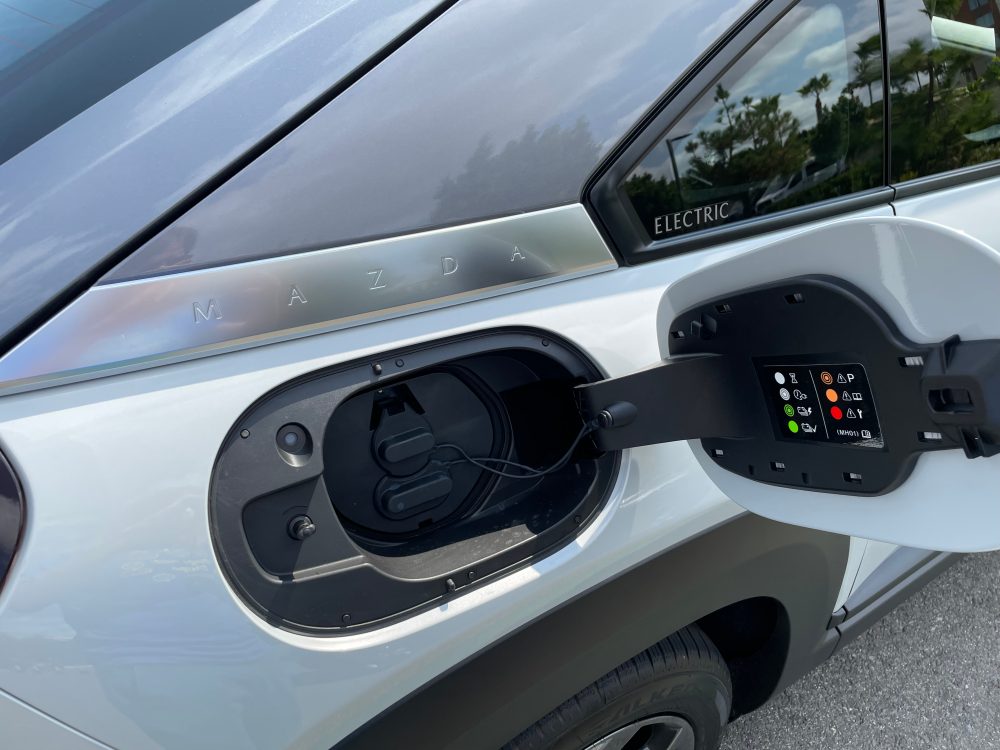
One aspect of the MX-30’s efficiency that leaves a lot to be desired is the regenerative braking system. While Mazda did well to include paddle shifters on the steering wheel to allow easy modification of regen strength, the car does not remember this setting between drives. Each time you turn the car on and off, you’ll have to flip the paddles to get to your preferred regen strength – an unnecessary annoyance.
Further, when starting a drive, the regenerative braking system didn’t even allow me to select “maximum regen” (two clicks of the left paddle) because when the battery is full, there’s no empty space to regenerate energy into. Many EVs restrict regen strength on a full battery, but when I began the drive, I attempted to set the regen as strong as possible (my preferred setting) and then went on my way. Perhaps this was a user error, but the car seemed not to accept my setting, and it turns out I did almost all of the drive on the normal, average regen setting, which I found to be not nearly strong enough. Even when eventually switching to maximum regen, I still felt like it could have been stronger and that the dream of one-pedal driving (which so many EV drivers love) feels like it is just a little bit out of reach.
While this is something that drivers will eventually get used to and learn to use, the system is not as simple as it should be. It should remember settings between drive sessions, perhaps attached to a driver profile (as Tesla does). In practice, drivers don’t modify regen settings all that often. Drivers usually find one setting they like the most, get used to it, and drive with that setting on all the time.
Finally, different regen levels also change the car’s throttle mapping. Mazda did this to maintain a linear feel of the pedal between different regen settings, but in practice, it just feels weird.
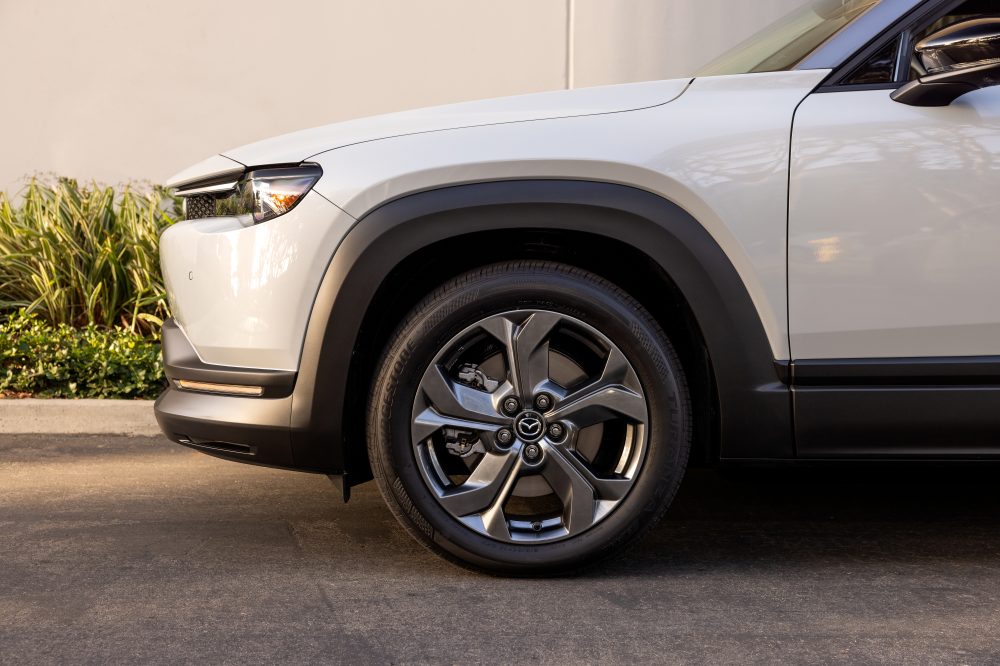
The MX-30 uses brake-by-wire, which means braking is done electronically. When you press the brake pedal, the car will decide how much regen and how much friction braking to apply. This can occasionally lead to weird situations where a car’s brake pedal doesn’t feel very linear as the car transitions from regen to friction braking, but in the short amount of driving we had in the car, we didn’t experience any of this weirdness in the MX-30. In general, I much prefer keeping the friction brakes on the brake pedal and having strong off-throttle regen, as this gives the driver more control over the vehicle, but Mazda’s implementation here was among the better-blended brake systems I’ve driven.
Style and tech gizmos
I’m a big fan of the look of this vehicle, both interior and exterior. There are two interior options, “modern confidence” and “industrial vintage,” which are the “light” and “dark” styles respectively. I drove the dark “industrial vintage” trim, which has a stylish, mature feel to it. The interior uses recycled materials and the center console makes use of cork, paying homage to Mazda’s origins as a cork producer in the 1920s.
The most unique part of the vehicle’s exterior is the car’s “freestyle doors,” with the rear passenger doors opening on a rear hinge. Doors like this are a bit funky and take some getting used to, but I like them. Different is fun, so why not? Your mileage, of course, may vary.
The car comes with your standard slate of infotainment features, including Apple CarPlay and Android Auto. But there’s no good place to put your phone, so mine ended up plugged into a stray lightning cable in the space underneath the center console.
Infotainment is controlled by a wheel in the center console, which is about as intuitive as you’d expect (not very), or by steering wheel controls or whatever voice commands your phone supports.
The climate control display on the center console offers a nice combination of physical and digital controls, giving you a choice to use whichever one you prefer. This makes for a good compromise without feeling like a compromise – it’s more like the best of both worlds.
A heads-up display comes standard, and this display is configurable to show various information that a driver might want to have readily available while driving. Which is all great, unless you’re wearing polarized sunglasses (oops).
Like several other cars these days, both gas and electric, the Mazda MX-30 pipes fake motor noise into the cabin through the speakers. This is meant to enhance the “emotional feeling” of driving according to Mazda. The MX-30’s particular motor noise is not particularly loud and not particularly unpleasant – it doesn’t feel quite as much like a weird alien spacecraft as some other fake motor noises do. Regardless, these noises are inherently silly and artificial, so it would be nice to be able to turn this off (like in the upcoming Genesis GV60).
Mazda does offer connectivity to the vehicle through the MyMazda app, which allows for remote control of charging and HVAC settings. It can search for charging points and send map locations to the car’s infotainment system.
The MX-30 does not have any Autopilot-like driver-assist features but does include many of the safety features that are becoming standard these days, like blind-spot monitors and lane-keep assist. The lane-keep assist worked very well, and the blind spot monitor worked perhaps too well – it triggered multiple times during normal “two left-turn lanes” situations. The Premium Plus package adds more safety features like front cross-traffic alert, blind spot assist, parking sensors, and a 360º view monitor.
Comfort, Practicality and Value
The Mazda MX-30’s interior is both attractive and comfortable, though the ride is a little stiff. It’s not offensively so, but it’s hard to square the car’s lack of performance with its so-so ride comfort level. On a sports car, you expect a bit of a stiff ride for a more connected handling experience, but this is not a sports car, so it really should be a little softer.
On the other hand, the feel of the car under acceleration is smooth and comfortable. As we noted above, Mazda wanted acceleration not to feel “jerky” for passengers. It is true that EVs can result in an unsettling experience for drivers and passengers due to their irresistible instant torque response, and for better or worse, you’re not going to get that in the MX-30.
The car has as much space as you expect out of a small SUV – plenty of headroom, reasonable legroom, and a large tall trunk. As a slim, 6-foot-tall reviewer, I had space to sit comfortably behind the driver’s seat when it was adjusted to my own liking, though if I were any larger it might have started to feel cramped.
There’s room under the floor of the trunk for tools, but unfortunately, there is not enough room for the portable charging cable. Mazda includes a bag that can be strapped to the side of the trunk area, as pictured, but this is less elegant than if it had a cubby or storage space that it could fit into. For many EVs, these charging cables are just left at home, where the car charges every night – but with the MX-30’s lower range, drivers will probably want to bring their cable around more often than in longer-range or faster-charging cars.
As for value, this is where comparison to the rest of the market comes in, and that comparison doesn’t look great.
Mazda states that the MX-30’s competitive position puts it in the same price and feature category as the Nissan Leaf and Hyundai Ioniq, and better-priced than the base Tesla Model 3 and Kia Niro EV – but all of those vehicles are both older and have much larger batteries than the MX-30. Plus, two of them are sedans anyway.
But the comparison to the Leaf is particularly interesting. The current iteration of the Leaf will have already been out for four years and is simply better than the MX-30. The MX-30 is more stylish, and the interior looks cooler. It also has a CCS port instead of the Leaf’s CHAdeMO port, which is more compatible, though both are limited to 50kW charging.
Other than that, the Leaf is just a better car. It’s got 50% more range and costs $6k less than the MX-30 after this year’s price drop (a memo which Mazda seems not to have gotten – they listed the Leaf’s base price as $31,670 in our press materials, rather than the actual $27.4k – again, before incentives). It’s more comfortable, faster, and is a “second-generation” EV that incorporates some lessons that Nissan learned from their first-gen Leaf, which Mazda will inevitably need to learn with their first-gen MX-30.
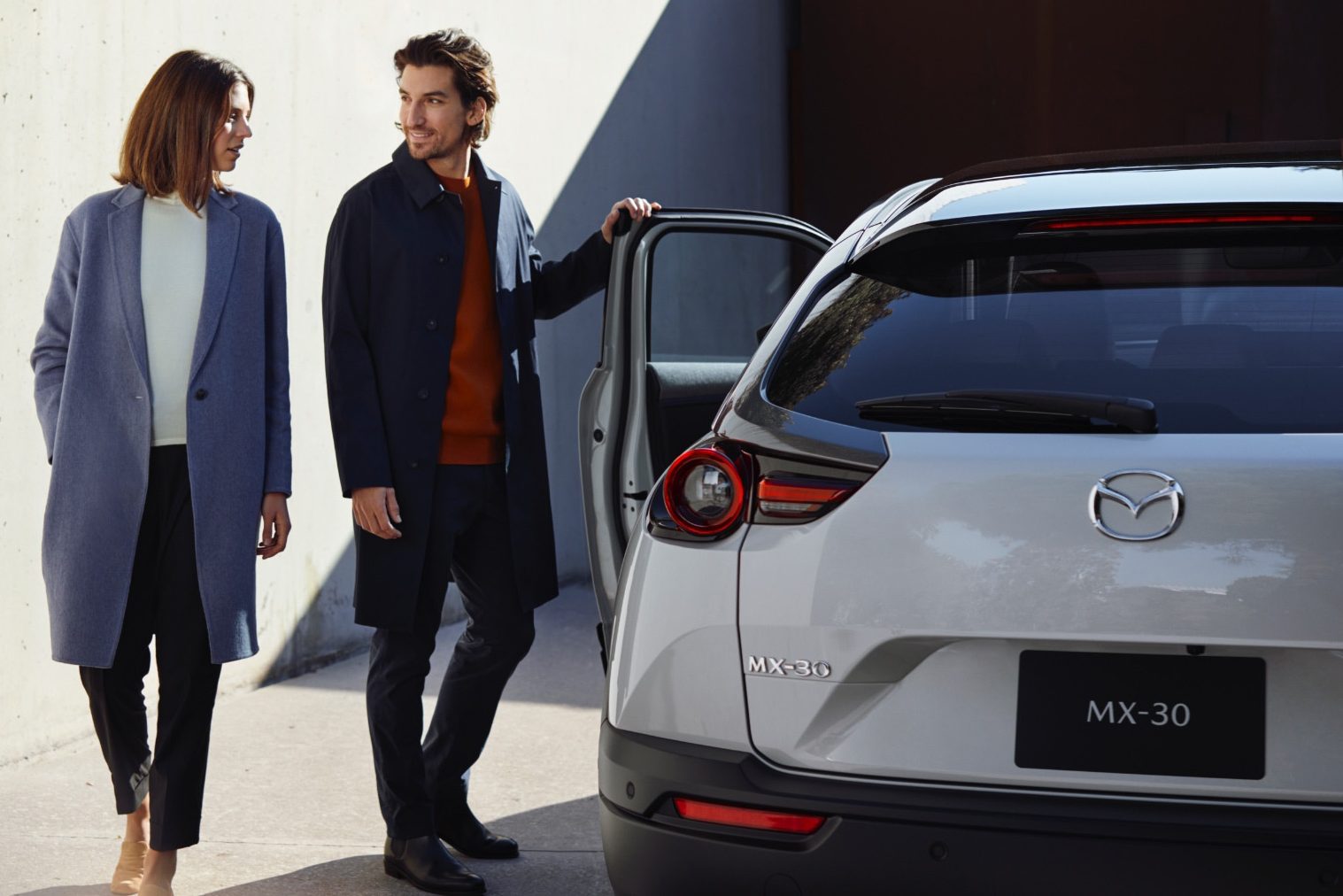
You can’t even say “well, it’s an SUV and I want a bigger car,” because the two cars are virtually identical in dimensions – with the Leaf being three inches longer, but the same width and height as the MX-30.
Again, this is not just a question of range – a lower-range car could still be a good value and can still meet the needs of more drivers than you’d think, and we’re glad to see some lower-range offerings available. The problem is that the MX-30 just doesn’t offer the right value proposition as a full package.
There may be a few features here and there that the MX-30 does better, or that certain drivers will like more, and there’s always the matter of personal taste and brand loyalty. But is this enough to justify the $6k higher price tag than the Leaf? I would say not. The MX-30 is just not a great value compared to other electric offerings. But…does it matter?
Conclusion (it’s ranting time, sorry)
Our title posted the question: “does it matter?” The answer, at least for the 2022 model year, is a resounding “no.”
Despite all the specs discussed herein, the 2022 Mazda MX-30 will only be available in California, so for almost 90% of the US (and ~50% of the US EV market), this review is meaningless.
But beyond that, even in California, the review is meaningless. Mazda’s first-year production will consist of exactly 560 units. No, that is not a typo.
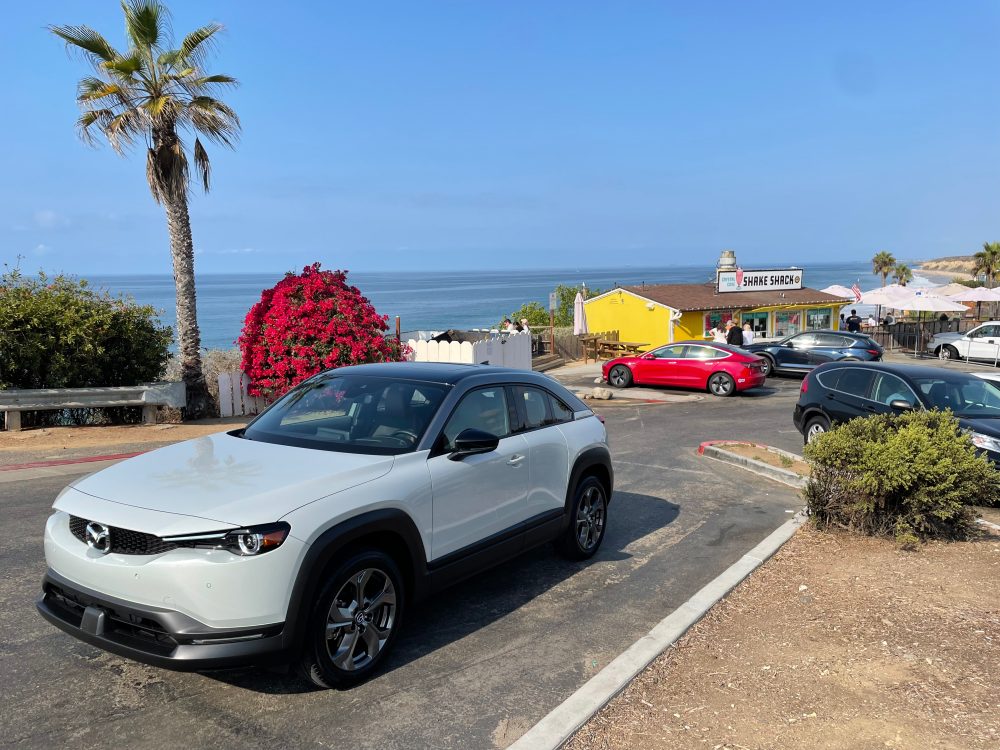
According to the California New Car Dealers Association, 11% of California’s new vehicle sales in the first half of this year were electric (BEV + PHEV), which represents 114,315 vehicles with a plug. The best-selling electric car in California this year, so far, has been the Tesla Model 3 at 19,746 units, out of a total of 49,875 vehicles sold by Tesla in California in the first half of 2021. That number is up 50% from the same time period last year and can be expected to increase next year as well. And all of these numbers are only for the first half of the year, so expect them to double by year-end.
Mazda’s 560 vehicles will represent a rounding error in these statistics. Compared to Mazda’s total sales in the state, which should run somewhere just above 50,000 units by the end of the year, the MX-30 will make up 1% of Mazda’s total sales in the hottest EV market in the nation, where 11% of vehicles are sold with plugs.
So Mazda doesn’t even have any cars to sell. The 560 cars they’re making will sell (or lease) easily enough, Mazda will get their ZEV credits so the state doesn’t fine them, and customers will be happy with their cars because an EV is better than whatever gas car they replaced anyway. Anything we’ve written here will make absolutely no difference in terms of sales. Apparently, I drove the car for my own edification and nothing else.
Worse yet, what really betrays Mazda’s lackluster sales plans for this model is the slated future availability of various hybrid models. Mazda says that they want to offer different powertrain options based on local conditions (charger availability, etc.), but did not specify what regions they see as having “good enough” conditions for BEV sales. Clearly, the EU is one of these regions as the MX-30 is already available there (and selling pretty well), and California has passed the threshold to get a handful of cars for 2022. In Japan, Mazda offers the MX-30 as a “mild hybrid” – a car that gets all of its energy from gasoline and does not have a plug. Beyond all that, Mazda would give us no specifics about planned future volumes between BEV and PHEV in the US/California.
In service of this future goal for the model line, Mazda has helpfully provided a gigantic void of wasted space under the hood which will be later filled by a dino-burning cancer machine. It’s not a frunk, because of course they wouldn’t want to make the EV better than the hybrids in any particular way, or put any additional engineering effort into it. But the space is big enough that I really thought I could climb in there and shut the hood behind me and fit, with enough contortion, and if I were able to ignore a few pokes and prods from stray components.
I’ve seen an engine compartment like this before, from another Japanese manufacturer, on the Honda Clarity EV. The BEV flavor of that 3-powertrain model had a giant space under the hood which was unutilized, because it was clear that Honda put its effort into the PHEV (and its favorite FCEV rainbow chase), with the BEV as an afterthought. Despite Honda’s worst efforts, the car didn’t sell very well and the whole model has now been axed, leaving them without an EV in the US.
If that isn’t enough to show you the electric model’s apparent planned status as the black sheep of the Mazda lineup, have a close look at the badging:
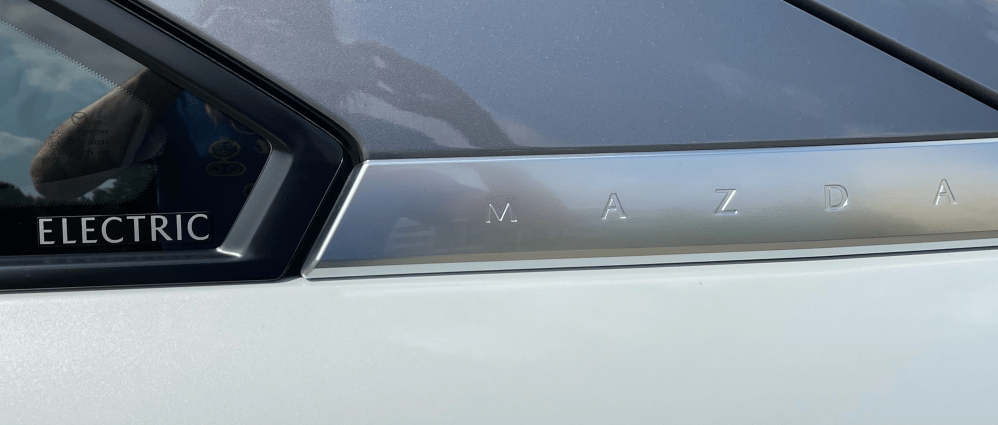
Yep, that’s right. It’s a sticker. On the window. Not even a badge, just a sticker. How could they possibly justify such extravagance?!
There is also an “e-skyactiv” badge on the rear, but this designation is shared with hybrid and PHEV models.
This is why you have seen such a current of snark and disappointment throughout this article. Mazda is far behind. The MX-30’s spec sheet looks like that of a limited production shared-platform compliance car from 2013. If the MX-30 had come out then and the only competition was the Tesla Model S, the original 24kWh Leaf, and the BMW i3 (a 100-ish mile range car with disappointing DC charge speeds, weird doors, and a high price… sounds familiar), it would be fine. But it’s coming now, as a California-only compliance car in 2022. What Mazda has given us is just not good enough – but it doesn’t even matter because Mazda’s not even trying to build and sell any of them! 560 cars! Come on!
“Falling behind” seems to be a common trend, especially with Japanese manufacturers. Japanese business culture is quite conservative in general, and their auto industry is a rogue gallery of companies that have been at the forefront of anti-electrification efforts. Toyota is the worst of them, but the others have made their fair share of boneheaded statements and strategy calls. Only Nissan took EVs seriously from the start, but even with its head start with the Leaf way back in 2011, Nissan has been slow to get its second electric vehicle, the Ariya, to market.
Mazda is finally toying with electrification, with the MX-30 finally hitting (*some) roads and plans for future BEVs on its own dedicated architecture starting around 2025. The company plans to only sell electrified models (including hybrids) by 2030. But it still feels like they aren’t moving fast enough.
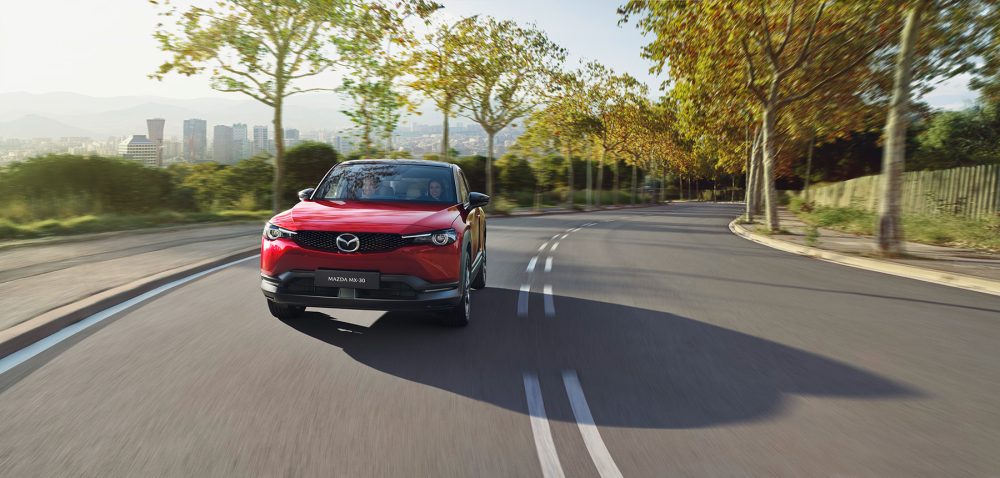
Mazda explained to us that, as a small company, it’s harder to invest a lot into new EV programs, and Mazda has spent so long “perfecting” the internal combustion engine (with the rotary albatross around their neck), and it needs the revenue from those gas cars to survive, and all the same excuses we’ve heard and expected to hear.
Mazda’s excuse is that they’re too small, but with a change in mentality, Mazda could see its small size as a strength. One reason the incumbent manufacturers have taken so long to come around is because they are so large and it takes a lot of effort to change large, staid organizations. Mazda’s smaller size could make it more nimble than the competition if it really threw all its effort into electrification.
In hearing from Mazda employees, each seemed reasonable, willing to embrace change, eager to drive the company into the future, and ready to accept criticism and suggestions. Surely, working at Mazda’s North American headquarters in Irvine, it must be apparent the direction things are going. EVs are enormously popular around here, more so than anywhere else in the country except the San Francisco Bay Area. Mazda’s Irvine employees must look out the window at various Irvine parking lots filled with Model 3s and recognize that the tide is coming in, but the message seems to be taking its time to get through to Japan.
The employees we talked to were proud of the vehicle they’ve released. And there are things to be proud of, it’s no small feat to get any car on the road, especially when it represents such a departure from your company’s and industry’s history. It’s not a bad car, it’s just not competitive with the other electric cars that are out today. It has fallen behind the rapid pace of innovation in the EV space and it’s going to take a lot of effort for Mazda to catch up.
And we sure hope they can, because we still really want an electric Miata (seriously, every time anyone says “Mazda” in Electrek’s Slack channel, everyone chimes in to beg for one. The latest: “Electrify the Miata you cowards!”).
Subscribe to Electrek on YouTube for exclusive videos and subscribe to the podcast.
